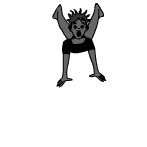Gymnastics
Created | Updated Jan 9, 2012

Gymnastics is an athletic sport which encompasses tumbling, running, jumping, swinging and stationary displays of strength, flexibility and balance, often making use of various items of equipment such as spring-boards, vaulting horses and suspended bars. Because the sport uses the whole body, concentrating on many different aspects of fitness and technique (rather than pure strength or pure speed, like many other sports), it can be considered the original Extreme Sport.
Modern gymnastics is generally agreed to have evolved from ancient Greek and Roman Olympic sports and military training exercises. Many of the pieces of apparatus, such as the vaulting horse, were originally designed to teach soldiers how to do things like mount and dismount a horse. Modern gymnastics came into being in the latter part of the nineteenth century and has since grown to the highly refined form it takes today.
In standard competition, following the rules laid down by the International Gymnastics Federation (which is incidentally referred to as the FIG, not the IGF, because the acronym is actually French), men compete on six pieces of apparatus and women on four. This uneven balance is because of the sheer physical strength required for some of the disciplines, which women cannot normally attain.
The Floor is a 12-by-12 metre slightly-sprung floor area on which gymnasts perform a one-minute routine of tumbling, somersaulting and strength and balance skills. Both men and women take part in this discipline, although women perform their routines to a piece of music of their own choosing, whereas men perform unaccompanied.
The Vault is a padded box on legs over which gymnasts must jump, with the aid of a long run-up and a spring-board. The approved technique involves gaining as much forward momentum as possible on the approach, then exchanging some of that momentum for vertical momentum using the spring-board and one's hands on the leading edge of the vaulting horse. Depending on the grip and orientation of the hands, it is then possible to sail over the top of the vaulting horse, flip around in one of many different possible ways in mid-air, finally landing on your feet. The only real difference between men and women on the vault is that the vaulting horse is oriented crosswise to the direction of approach for women and lengthwise to the direction of approach for men.
The remaining men's disciplines include:
The High Bar is a single horizontal metal bar, suspended about 3 metres above the floor, around which the gymnast swings using their hands, occasionally releasing and then re-grasping after some flashy aerial manoeuvres.
The Pommel Horse is a vaulting horse with two upwardly-pointing handles which the gymnast grips while swinging his entire body through the air in circles and arcs. He must not touch the handles or the rest of the horse with any other part of his body during the routine. This is very upper-body-strength-intensive.
The Parallel Bars are two wooden rails, set about 2 metres above the ground and about 50 centimetres apart, between which the gymnast swings, moving his whole body above and below the bars.
The Rings are a pair of wooden rings hanging from cables attached to the ceiling which the gymnast grips and swings from. Rings present a special challenge because they are the only apparatus not fixed firmly in place, and gymnasts are required to perform a combination of stationary strength 'holds' and swinging moves in the same routine.
The remaining women's disciplines are:
The Beam is a 10 centimetre-wide raised beam upon which the gymnast performs tumbling and balance moves similar to those performed on the floor.
The Uneven (or Asymmetrical) Bars are similar to men's High Bar, but there are two bars about 2 metres apart horizontally and 1 metre vertically. Gymnasts swing on each bar in much the same way that they would on a High Bar, but they can also leap back and forth between the two bars in the course of their routine.
I'd also like to add a few more points about gymnastics from the personal experience of this researcher.
It's really great fun!
It's also excellent for your fitness.
You don't have to start as a child - it's easy to pick up as an adult or teenager, especially if you want to do it for fun, as opposed to competitively.
If you do find yourself doing gymnastics one day, Don't Panic. It's a lot safer than it looks or feels, and gymnasts have a funny habit of messing things up in the middle of a complicated routine, collapsing upside-down in a screaming heap, then walking away completely unscathed. Then, of course, they go and dislocate every bone in their bodies doing things like walking over an uneven patch of carpet.
So remember, if you're going to injure yourself you might as well enjoy the experience of leaping gracefully through the air or swinging like a monkey first!

